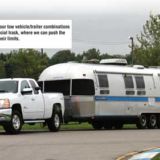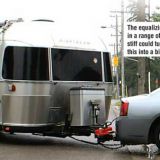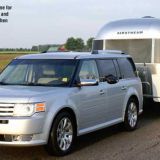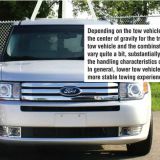
“Spring has sprung, the grass has riz, I wonder how my RV is”
It is spring and the flowers are up, my lawn needs to have the first mowing and I am looking at my trailer in the driveway and thinking happy thoughts about being out camping, despite the current dark cloud of Covid 19 that we are enduring this season. For many trailer owners this is the time of year that they drop off their rig to Can Am to have it de-winterized. If you have some time on your hands, a bit of mechanical aptitude this might be a good opportunity to learn how to de-winterize your travel trailer yourself.
I have always winterized and de-winterized my own trailers and I think it is a good way to get to know how everything functions and see the details of the rig up close. If you drop your trailer off somewhere and get it done for you, you might never know where important components are and what to do if something acts up or fails on the road. Although every trailer is different, lets look at 10 items that are likely universal to all brands and models. Also, PLEASE check your owners manual for details about maintaining and winterizing your specific model. You will be surprised how much information is in your manual!
The Exterior
This is a good place to get reacquainted with you trailer. Hopefully you put it away clean last fall, but either way start with a really good washing, starting at the top. With an Airstream, a short ladder or a tall step stool will get you high enough to hose it down, but with a taller trailer or a 5th wheel, it is certainly a tall order and best left for a RV technician to tackle. For instance, on an Airstream you have to know where to step. Stepping in the wrong place can cause you to buckle and dent the skin for sure. Look for cracked caulking around vents and access or storage doors. It is very important that any possible leak is corrected as soon as you find it. A leak that is not repaired will result in a ton of later problems like wet insulation, mold, delaminated walls and floors that will disintegrate. Wash the whole trailer after checking all your windows and doors and compartments with a quality car wash, Dawn dish detergent or better yet an RV wash like Thetford RV Wash and wax. We have a great selection in our parts department. While washing take note of any loose screws, rivets, dents or cracks in lights you might find.
If you have an awning this is a good time to extend it, rinse it and leave it out to dry. It is important to know that fabrics like Sunbrella should not be washed with soap as it can make them leak. Check with your owners manual for specific care recommendations for your awning. Check for any rodent damage and make sure there is no wear and tear at the ends of the awning rail. If you have an electric awning you should wait until the end of the de-winterizing process to do this after we check the batteries. If you have power available check your running lights, turn signals and brake lights at this time and replace any bulbs that are out.
Tires

While still outside the trailer check the tires carefully. They will have likely lost pressure over the winter storage period and will need to be put back to the recommended pressures. See the tire manufacturers inflation chart to make sure you are properly inflated for the load you carry. Do a careful visual check of the tires to make sure that there is no evidence of cracking on the sidewalls. Trailer tires rarely are replaced because of tread depth like on your car. Trailers tires dry out and crack long before they wear out. Depending on where you store your trailer and if the tires are protected from the sun’s harmful rays will determine how many years you get out of them. Also check the sidewalls on the inside as well for any cracks or road damage. I can’t emphasize enough how having good tires are essential for safe travel. This is not an area to cut corners on your RV budget. If you are unsure call our parts and service department for advice.
Propane

Since we are still outside it would be a good time to check your propane tanks. Remove the cover if you have one and make sure that the tank valves are in the off position. You need to make sure that there is actually propane in the tanks before testing for leaks and the operation of your appliances. You may have an indicator or a tool that measures your tank, but I usually just loosen the hold down bracket and lift it up. It should be fairly heavy. When you are sure that there is a good quantity of propane in your tank do a visual check for cracked hoses or rodent damage. Rubber parts like this can deteriorate and get brittle. Replace a bad hose before turning on the propane.
To check for leaks make a mixture of dish soap and water and apply it to all the joins around the tank and regulator. I use a small cup and a paint brush to apply it where I need it. If there is a leak when the gas is turned on you will see bubbles form around the join. Be patient and look very closely it might take a few minutes before a slight leak shows up. To pressure test the complete propane system turn on the tanks and the green indicator should show indicating pressure in the lines. After it is showing as green, turn the tanks off again. The indicator will still show as green and should stay this way for at least an hour. If the indicator changes to RED in less than an hour it may indicate that you have a leak somewhere in the system. If you suspect that there is a leak it should be checked by an RV technician with the proper tools to pinpoint the problem.
When you are sure all is good outside go inside to check your appliances. Make sure your propane detector is on and has a fresh battery every season. I always start my test with the stove. Turn on a burner and listen for the sound of the gas escaping. The stove may not light on the first try as there may be air in the lines. Make sure that you see the spark of the ignitor in the burner area. Keep trying the ignitor a few more times until the burner lights. If you are smelling gas but not getting the burner to light you may have a problem with the ignitor. STOP trying to light the stove and open a window to ventilate the trailer. If you have the stove going, try all the burners and let them burn for a couple of minutes. The flame should be steady and blue, not flickering and orange. You can now run your furnace to make sure it is working. Before you try your refrigerator make sure the outside vent cover is clear and an opportunistic bird or mouse has not set up a home there. Another word of advice about opening a refrigerator that has been in storage with the door closed. Stand back when you open it! Although rare, if a unit has failed and released refrigerant into the interior it is a highly toxic gas with an ammonia odour. You will have to evacuate the trailer right away if that happens.
Set the fridge on Gas if you are plugged into shore power and with the door closed let it run. When you turn it on you will hear a clicking of the ignitor and a quiet “swoosh” as the burner lights. It will take a while to know if your fridge is cooling, especially if you are in a cold ambient temperature. Put a thermometer inside and let it run a couple hours to make sure all is well.
After you are sure the refrigerator is working perfectly on Gas, shut it off, open the door and let the temperature rise and then switch to electric and test it again. It is quite common for a refrigerator to work well on one source and not the other. This is the time to give it a thorough test. You do not want to find out when out camping with a full load of food that it only works on electric when you are boondocking.
DO NOT test the water heater yet. It is likely empty and we will test it after our water system check.
IMPORTANT: any doubts you have about your propane system or any leaks you find should be addressed by a certified RV technician.
Interior

Now that you are inside testing appliances you should take the time to do a visual inspection of the interior. You may want to do the spring cleaning now but if not we still need to do a careful look through to check for water damage and evidence of insect or rodent damage. Starting at the top check around all of your windows for any signs of water infiltration. This may present in stains on drapes, drip lines on walls below windows or residue from puddles on the floor. Again a simple leak undetected can do thousands of dollars of damage to your RV. In an effort to make RVs lighter over the years manufacturers use a variety of lightweight materials in floors and walls. These weight saving materials will not stand up to moisture and will delaminate and fail in no time at all. In a curved design like that of Airstream a leak may present quite a distance from it’s place of origin as it travels along the curved ribs. If you find evidence of a leak that you cannot source yourself, Can Am has advanced leak detection equipment that alters interior cabin pressure to find the problem. Check for evidence of leaks under the refrigerator and around the furnace as these items are vented outside and can be a source of water infiltration.
Check inside cupboards and closets for evidence of insects and mice. Smell my be the obvious indicator but look for frayed materials, seeds and droppings. If you think you may have had mice visiting in the off season look even more carefully to make sure there are not wires or plumbing that have been chewed up.
Open the windows and lubricate all your seals and mechanisms to ensure good operation all season. With a frameless window like that used in an Airstream the glass has been known to stick to the rubber making the first opening difficult. Don’t force the window open but try to get a piece of dental floss through and drag it around the opening to clear the seal. If a window is left “stuck shut” like this and is being towed, the glass has been known to shatter as the body of the trailer flexes in transit.
Filters
If your RV has an internal water or air filter this is the time to check and likely change that. The only filters I have to check and clean in our rig are my air conditioner intake filters and the exhaust fan filter over the stove.
Batteries
Batteries are an expensive and critical part of your RV’s power system and good storage and maintenance practices will save you a lot of time and headaches when done properly. Batteries will loose their charge steadily when in storage and will need a thorough recharging in the spring. Some owners take their batteries out of their RV and keep the batteries on a maintenance charger all winter. Other owners may be able to keep the RV plugged in all winter with the trailer’s internal charger keeping the battery charged up. Before you start checking and working on your batteries make sure that the trailer is disconnected from shore power and that you are wearing eye protection and gloves. Turn the main battery power switch off.
First do a visual check. If a battery has gone dead in a trailer left outside it will freeze. If it freezes it will noticeably swell. Look for curving sides or top of the battery. If this is the case the battery is no good and will have to be replaced. Before moving or touching it make sure that it has not cracked and leaked battery acid. The other bad news is that if your trailer has multiple batteries they should all be replaced at the same time. Otherwise the older batteries will draw down the new battery and speed up failure.
I always take a photo before I remove all the cables for cleaning. Even though I am sure I know where they all will go when I reinstall, a photo is an bit of extra piece of mind. Clean all the cable connections and battery terminals with a mixture of baking soda and hot water. Wire brush all the parts and reassemble.
Helpful Hint: If your trailer (like mine) overcharges your batteries when left plugged into shore power for an extended period of time consider plugging your trailer into a block heater timer available at any hardware store. You will have to use an adapter to step down from 30 or 50 amps to 15 amp. Set your timer to only run a couple hours a day and this should remedy an overcharging issue. I was finding that my batteries would literally boil dry in storage if left plugged in all the time.
Check the battery fluid level and as long as the fins inside are covered, charge the battery and check again. If you are going to top up the battery use distilled water and it is best to top up a fully charged battery.
Waste Tank Valves

Let’s hope that you put your trailer away for winter with empty black and grey water tanks. Although a couple gallons of waste in the tank would not have like caused a tank to freeze and split, the sediment hardening on the inside of your valves can be a big problem.
Being very gentle and with a bucket (or two) at the ready open your grey valve very slowly. If it seems to be stuck do not apply additional pressure. You may be wondering why I am suggesting doing the grey water valve first when the usual dumping procedure is Black before Grey. I am trouble shooting the Grey water valve first because if we do have a problem that is going to require a trip into the Can Am service centre then I may as well leave the Black water valve alone as having it fail in the driveway is going to be a bigger problem.
If either valve seems to be sticking you can add a tank lubricant and let it sit for a while to soften up the valve seals. I have used coconut oil instead of a commercial tank lubricant with complete success. When the valves are functioning well I would suggest putting a gallon of water in each tank and dumping into a bucket or better still do this at a dump station when possible. The “output” from tanks will likely need to be flushed down a toilet if you are doing this at home. When all is working and flushed leave a gallon or two of water in both tanks to soften any residue inside the tanks.
Sewer Hoses
While we are on this stinky topic I would recommend that you test sewer hoses each spring. Hold both ends of the hose up and fill the hose with water to check for leaks. If you don’t do this periodically you are only going to find out the the hose failed when you are at a public dump station with three other trailers lined up behind you. And that sewer hose that is left behind by the last guy...no it’s not going to be your spare, it’s there because it leaks.
I keep a brand new in the box sewer hose with me at all times so that when needed it is there. I
keep extra hose clamps, an elbow and an extra dump station drain adaptor. ( I am leaving those behind now and then) I actually even carry a Twist On Waste Valve for emergencies. This is a valve that attaches where your sewer hose is and gives you a new valve instantly. If you ever had a valve fail or something stuck in the seal and the valve was dripping this $40.00 piece of plumbing will save your vacation. I figured that out the hard way!
Fresh Water System

I left the water system until the end so that if you are running water and filling your tanks we at least know that your valves work to let the water out again. First let’s turn the water heater bypass valves to “summer” or “normal” however they are marked. Your owners manual might be needed if you are new to this step. This allows water to flow back into the water heater tank so that we can light the burner and test the system.
Connect your RV to city water and turn the tap on only part way. Check inside the trailer to see if there are any taps left open and running. If so turn them off. Check for any leaks under the sinks and in the shower area while the tap is still supplying lower pressure. Check under the trailer for any visible leaks. If there was a low point drain left open there may be water escaping from there. Close all drains and turn the water tap on all the way. Again check for any outside or inside water leaks. Now carefully turn on the cold water tap in the kitchen sink. It is going to sputter and splash as the air is pushed out of the lines. If you winterized with RV antifreeze then you will be getting a steady pink stream coming out of the tap. Now try the other taps both hot and cold in each area of the RV. They should all be running steady and the pink should have turned to clear. Check again for leaks under the counters and in the shower. Check your hand held shower head as well. It is often overlooked when winterizing and can freeze and crack. Flush the toilet a few times until it too is running clear and no antifreeze is seen. The bowl may need cleaning to remove a pink stain from the antifreeze.

Now you can turn off the water and disconnect from the tap. Put some water in the freshwater holding tank and then run your pump to get the pump cleaned out as well. With the taps turned off it should take a minute to pressurize and then shut off. If it doesn’t shut off or comes back on with the taps turned off you could have a leak somewhere and the system wont hold pressure.
I would also recommend sanitizing your freshwater system by adding 1cup of bleach for 48 gallons of water you are putting in the holding tank. Let that sit for four hours and then flush it out and run the water until it no longer smells like bleach.
Appliances.
We have already tested the furnace and the stove and refrigerator. Now that the water system has been tested you can check your water heater on gas and electric modes. Check the other appliances like the microwave and the oven to make sure they also are working properly.
Although this may seem like a lengthy undertaking to get the trailer ready for camping season the benefit of knowing your systems better and having piece of mind that all is ready to go when you hit the road will make it all worth it. Owning an RV sales is an awesome way to see the world and when well maintained and looked after, even when in storage, it will provide many years of faithful service. Having a working knowledge of how things work can save a vacation if you do not have to be side lined to an RV dealership for a simple repair. And remember at Can Am we are here to help everyone from the beginner to the most experienced RV’r. Call our service and parts department for your needs and questions.
Sign Up! Our Can Am RV Newletter features Tech Tips, Destination Reviews, Customer Spotlights and more! Click Here.










